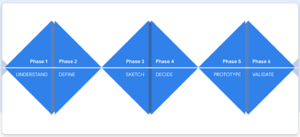Public:Product Design Sprint: Difference between revisions
| Line 38: | Line 38: | ||
== Examples == | == Examples == | ||
* [https://miro.com/welcomeonboard/cllBN3VYWW5kYU5XQWQydE5DYTh0aldNdUZqVHBKNmtKRXVXdVllYktzbnpjeXhiUjV3T3g2d2ZyRGxRODFvU3wzNDU4NzY0NTQ3MDQ3MDY5MTkwfDI=?share_link_id=439269932868 Kray: Guide Users "What to Search" Design Sprint] | |||
* [https://miro.com/welcomeonboard/UGhGWkN4TnNVMWtrR05PSzYwZHEyWFNRa2VEUUthUFEzSUhEaktQQ0xIVHVLUk9UTWVLUnhzQ0haNWtpcDUzbHwzNDU4NzY0NTQ3MDQ3MDY5MTkwfDI=?share_link_id=527809790731 TLANT Chef's Breakfast Tool Design Sprint] | * [https://miro.com/welcomeonboard/UGhGWkN4TnNVMWtrR05PSzYwZHEyWFNRa2VEUUthUFEzSUhEaktQQ0xIVHVLUk9UTWVLUnhzQ0haNWtpcDUzbHwzNDU4NzY0NTQ3MDQ3MDY5MTkwfDI=?share_link_id=527809790731 TLANT Chef's Breakfast Tool Design Sprint] | ||
* [https://miro.com/welcomeonboard/N2dtMEtKam5nNFNGTXBSbzB0cEJWa0hEU25JdlRaNkJmRjdUcHJWSklQNFdjVjVCWkdtdGZSdTZzMWJKUGZuRHwzNDU4NzY0NTQ3MDQ3MDY5MTkwfDI=?share_link_id=774408194127 Synterex (Agile Writer) Design Sprint] | * [https://miro.com/welcomeonboard/N2dtMEtKam5nNFNGTXBSbzB0cEJWa0hEU25JdlRaNkJmRjdUcHJWSklQNFdjVjVCWkdtdGZSdTZzMWJKUGZuRHwzNDU4NzY0NTQ3MDQ3MDY5MTkwfDI=?share_link_id=774408194127 Synterex (Agile Writer) Design Sprint] | ||
* [https://miro.com/welcomeonboard/bjloem9VWnlSeUdkREY0bEFFMnZsaEp4NHpMbll2UUsyWXViUWNwOEt0YVFZajlNZXVTbXRTdjRCdE5TMjBHNHwzNDU4NzY0NTQ3MDQ3MDY5MTkwfDI=?share_link_id=189634504239 Document Chatbot Design Sprint] | * [https://miro.com/welcomeonboard/bjloem9VWnlSeUdkREY0bEFFMnZsaEp4NHpMbll2UUsyWXViUWNwOEt0YVFZajlNZXVTbXRTdjRCdE5TMjBHNHwzNDU4NzY0NTQ3MDQ3MDY5MTkwfDI=?share_link_id=189634504239 Document Chatbot Design Sprint] | ||
== References == | == References == | ||
<references /> | <references /> | ||
Revision as of 15:02, 29 May 2024
A Product Design Sprint is a 5 days, five-phase process (one day for each phase) that uses design thinking with the aim of reducing the risk when bringing a new product, service or a feature to the market.[1]
Phases of a Design Sprint


Map [or Brainstorm]
In this phase the business opportunity, the audience, the competition & the value proposition are discovered; and metrics of success are defined.
In simple words, the problem (that's needed to be solved) will be picked in this phase.[2] Hence, Jake Knapp calls this phase as Map.[3]
Google alternatively divides this Phase in 2 phases as Understand[4] & Define[5].
Sketch [or Ideate]
In this phase broad range of Ideas are suggested by Design Sprint Team as a Solution for the Problem selected in the Brainstorm Phase.
These ideas are shared in the form of rough sketches, hence this phase is also known as Sketch.[6][3]
Decide
In this phase, the Design Sprint team finalizes the direction or concept to be prototyped, by selecting from the solutions suggested in Ideate phase.[7]
Prototype
In this phase, the Design Sprint team will work together to create a prototype of the concept finalized in the Decide phase.
Test [or Validate]
In this phase, the prototype is shared with the audience (discovered in the Brainstorm phase) to gather their feedback & response through observations & interview.
Based on the outcome of this phase:
- If the concept is validated, then the prototype will be sent for development.
- If the concept is not validated, then the prototype will be sent for improvement accordingly. This will start a new sprint.
Due to it's nature this phase is also known as Validate Phase by Google.[8]
Examples
- Kray: Guide Users "What to Search" Design Sprint
- TLANT Chef's Breakfast Tool Design Sprint
- Synterex (Agile Writer) Design Sprint
- Document Chatbot Design Sprint
References
- ↑ Wikipedia: Design sprint
- ↑ Google Venture's: Sprint Process in 90 Seconds
- ↑ 3.0 3.1 The Sprint Book: The Design Sprint
- ↑ Google Design Sprint Kit: Phase 1 - Understanding
- ↑ Google Design Sprint Kit: Phase 2 - Define
- ↑ Google Design Sprint Kit: Phase 3 - Sketch
- ↑ Google Design Sprint Kit: Phase 4 - Decide
- ↑ Google Design Sprint Kit: Phase 6 - validate
